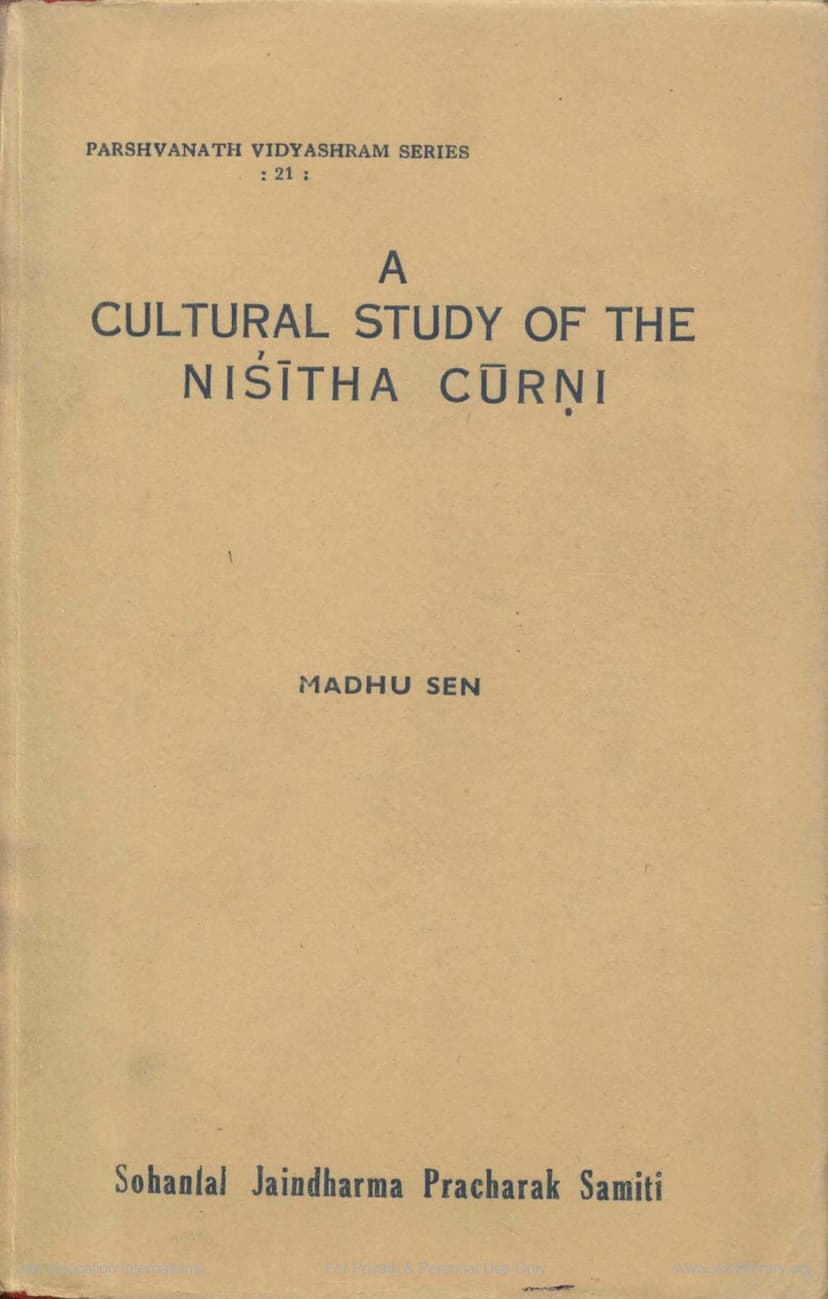Cultural Study Of Nisitha Curni
Added to library: September 1, 2025

Summary
This detailed summary outlines the cultural study of the Niśitha Cūrṇi by Madhu Sen, published by Sohanlal Jaindharma Pracharak Samiti Amritsar in 1975. The book, stemming from a PhD thesis, analyzes the Niśitha Cūrṇi, a significant commentary on a Jain canonical text, to understand the cultural life of early medieval India.
Key Aspects of the Study:
-
The Niśitha Cūrṇi: The study focuses on the Niśitha Cūrni, a prose commentary by Jinadāsa Gani Mahattara from the latter half of the 7th century AD. It's considered invaluable for its exhaustive treatment of Jain ethics and monastic rules, offering a realistic portrayal of daily life, in contrast to classical Sanskrit texts that focus on higher strata. The Cūrni provides insights into both ancient traditions and the author's contemporary observations.
-
Author and Context: Jinadāsa Gani Mahattara, the author, is described as a learned scholar with deep knowledge of religious, social values, and human nature. While little is known about his personal life, references within his works help establish his association with the Lața country (modern Gujarat) and his flourishing period in the last quarter of the 7th century AD. The book highlights the historical gap between Harsha's reign and the Muslim advent, and how the Niśitha Cūrni helps fill this void.
-
Methodology: The study aims to critically analyze the Niśitha Cūrni from various cultural perspectives, supplementing and corroborating information with contemporary sources.
-
Content Breakdown: The book is structured into eight chapters:
- Introductory: Discusses the Niśitha Sutra, its commentaries (Niryukti, Bhasya, Cūrni), the nature of Cūrni literature, Jinadāsa Gani's authorship and date, the geographical background of the NC., and an analysis of its contents.
- Polity and Administration: Explores various forms of government, the role of the king and his council, military organization, police system, espionage, treasury, revenue, judiciary, administrative units, and town and village administration. It notes a disturbed political administration despite well-developed political ideologies.
- Social Life: Details the society's structure, caste system (including Jaina perspectives on untouchables), family life, marriage customs (including various forms), pastimes, customs, and beliefs. It highlights the sense of materialism and status consciousness among people.
- Material Culture: Examines food habits, dress (including types of cloth, materials, and seasonal wear), shoes, ornaments, use of flowers, toiletries, medicine, and health practices. It also covers the availability and preparation of various food items and drinks.
- Economic Conditions: Covers agriculture, arts and crafts, labor, trade (both inland and foreign), coinage, weights and measures, banking, and loans. It points to economic prosperity with significant wealth disparities.
- Education, Learning and Literature: Focuses on the Jaina system of education, teachers' qualifications, students' profiles, study routines, curriculum, the method of oral transmission, the role of writing and books, special facilities for higher studies, and the art of debates (Vada). It also touches upon Brāhmaṇic institutions (Gurukulas) and primary schools (Lehasālās).
- Fine Arts: Discusses architecture (religious and secular, including palaces, houses, drains, bridges, wells, and planning), sculpture (images of deities, humans, animals), painting (religious and erotic themes, techniques), music (vocal and instrumental, classification of instruments), dance, and drama.
- Religion: Explores Jainism, its historical changes and adaptations, its relationship with Brāhmaṇism (Śaivism and Vaiṣṇavism), and Buddhism. It details Jaina practices like festivals (Pajjusana, Ashtānhika, Indramaha), fasts, pilgrimages, and the animistic beliefs that influenced Jainism. It also describes Śaivism, Vaiṣṇavism, and the practices of various ascetic groups like Kāpālikas and Haddasarakkhas, highlighting the hostility between Jainism and rival sects.
-
Cultural Significance: The study emphasizes how the Niśitha Cūrni, originating from a monastic source, provides a realistic depiction of Indian culture, encompassing social customs, material prosperity, economic activities, educational systems, fine arts, and religious life. It highlights the influence of social and political changes on religious practices and the adaptability of Jainism to survive and propagate.
In essence, "A Cultural Study of the Niśitha Cūrni" is a comprehensive analysis of a crucial Jain text, offering a valuable window into the multifaceted cultural landscape of India during the early medieval period.